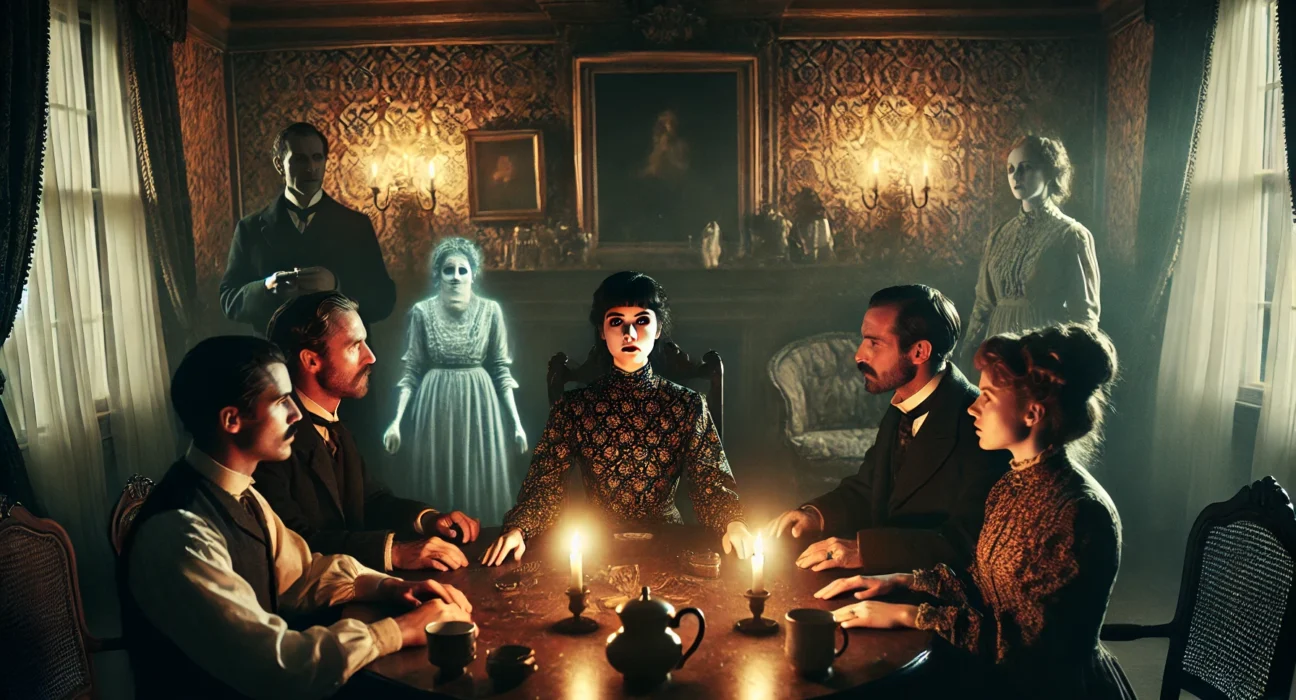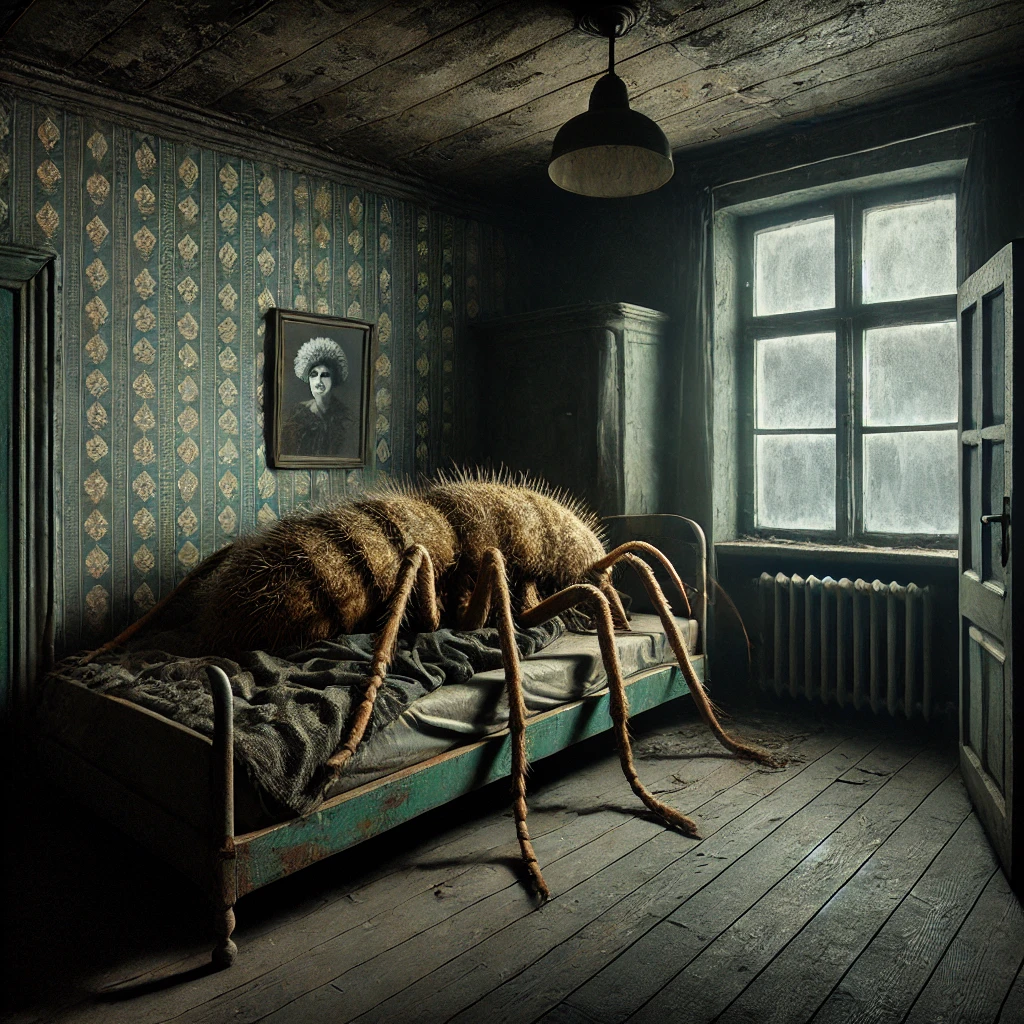The Demon Spell, written by Scottish-Australian author Hume Nisbet and published in 1894, is a horror short story that taps into the spiritualism craze of the late 19th century. Set against the backdrop of Victorian England, the story blends themes of the supernatural with elements of psychological terror. Nisbet, an author known for his tales of the macabre, creates a chilling narrative that explores the thin boundary between the physical and spiritual worlds.
Plot Summary
In the dim, flickering light of a London parlor, a group of people gathered for a séance, their hands resting on a table, waiting for something unseen. It was the height of the spiritualism craze, and séances were a common evening entertainment, drawing skeptics and believers alike. Among the assembled was a man who had been invited by a friend, intrigued but doubtful. The friend promised him an evening unlike any other, led by a young trance medium, a girl reputed for her beauty and her strange, otherworldly gift.
As they waited, the medium entered silently, a delicate figure who seemed to float into the room. She took her place at the table, her presence immediately casting a strange spell over the group. The dim light made her appear almost ethereal, her pale face framed by shadows. As the group began their séance, singing hymns to set the mood, an eerie quiet fell over the room, and the medium, her head bowed, joined in the chorus.
With hands placed on the table, they waited for the first sign of a spirit. The medium remained still, but soon, the table began to tremble, soft knocks echoed in the room, and the air grew thick with an unexplainable tension. As the lights dimmed even further, the medium’s features seemed to change, her youthful face darkening as if something older and more sinister had taken control. In a distant voice, she began to speak. It was not the voice of a girl, but of a tormented soul, one that claimed to have suffered a violent death in the foggy, dangerous streets of Whitechapel.
The voice spoke of her life, one filled with hardship and misery. She had wandered the streets alone on the night of her death, cold, hungry, and desperate. That night, a figure approached her in the fog, a man with a soft voice and an air of kindness. But his kindness turned to cruelty, and in the murk of the streets, her life was stolen by an unseen force that choked her, leaving her body mutilated and discarded in the gutter. As the medium continued, the room felt as if it were closing in on itself, the horror of the spirit’s tale seeping into the air, gripping everyone present.
When the séance finally ended, the medium collapsed into her chair, her face soft and innocent once again. She had no memory of what had passed, as though the spirit that had spoken through her had left no trace. The others, still shaken by the events, dispersed into the cold night, but for one man, the sense of dread had not lifted. Something had followed him home.
As midnight struck, he lay awake in his room, the gaslight burning low. The night outside was quiet, but inside, the air felt thick with a presence he could not shake. It began subtly—a faint tug at the edges of his blankets. Slowly, his bedclothes were pulled to the floor, as though an invisible hand had taken them. His heart pounded in his chest as he sat up, realizing he was not alone. A soft voice, barely more than a whisper, echoed in the room, urging him to act quickly, to save the girl—the trance medium—from a fate that awaited her.
Though he hesitated, fear overtaking him, the voice persisted, and he rose, throwing on his clothes. He grabbed an old Kandian dagger from his table, its blade sharp despite being a relic of his travels. Without knowing how, he found himself rushing through the snowy streets, guided by something unseen. The voice, faint but insistent, led him through twisting alleys, past snow-covered buildings, until he stood before a silent square, where a single house waited, its windows dimly lit.
The man pushed through the door and found his way up the stairs, moving as though in a dream. The air inside was heavy, almost suffocating, and as he entered a bedroom, he saw the medium struggling, her face pale as the same dark entity from the séance wrapped its clawed hands around her throat. The room swirled with shadows, and the demon’s form seemed to shift, part muscle, part mist, its features barely human. Without hesitation, the man lunged forward, slashing at the creature with his dagger.
Each strike seemed to wound the thing, streaks of blood appearing in the air as the demon howled in silence. As he fought, the medium gasped for air, her body limp in the demon’s grasp. Finally, with a final blow, the creature began to dissipate, its claws retracting as it faded into nothingness, leaving only a strange coin clutched in the medium’s hand. The girl collapsed, freed from its grip, as the house erupted into chaos, her screams awakening the other residents.
The man fled, stumbling down the stairs and back into the snow-covered street. His breath came in ragged gasps, but his task was not yet complete. Across the square, a figure lay crumpled in the snow. It was the same man he had glimpsed earlier, standing in the shadows, watching the house. Now, his body lay lifeless, and as the man approached, he saw the unmistakable signs of the demon’s work. The figure’s throat was slashed from ear to ear, his face pockmarked and twisted with evil, matching the demon’s description perfectly.
The man recoiled in horror as the snow around the body slowly turned crimson. The clock struck one, its echo carrying through the empty streets, and from somewhere in the distance, the sound of church bells rang out, heralding a Christmas morning unlike any other. He stood for a moment, watching as the blood soaked into the snow, before he turned and vanished into the night, leaving behind the echoes of a terrible encounter with the unseen.
Main Characters
The Narrator: The unnamed protagonist is a skeptic of spiritualism, but due to his fragile health and nervous disposition, he finds himself easily influenced by the eerie atmosphere of the séance. As the story progresses, he is drawn deeper into a terrifying supernatural experience, despite his initial cynicism.
The Trance Medium: A young and delicate woman, initially described as “heaven-gifted” and beautiful, she becomes the vessel for unsettling spiritual manifestations. Through her, a tormented soul speaks, revealing dark and horrific details of her murder, turning the séance into a horrifying encounter.
The Spirit: A lost soul, previously a woman who lived a wretched life as an “unfortunate” in Whitechapel. She recounts her tragic murder, which was committed by a demonic entity. This spirit plays a central role in both the séance and the subsequent haunting of the narrator.
The Demon/Entity: A shadowy, malevolent figure, described as having a dark, pock-marked face and claw-like hands. It is responsible for the murder of the spirit and continues to exert its evil influence on the living, targeting the medium and the narrator.
Theme
Spiritualism and Séances: The story explores the Victorian fascination with spiritualism, a movement that sought to communicate with the dead through mediums. Nisbet uses the séance as a portal to the otherworldly, blending superstition with horror to question whether spirits truly exist or are figments of the imagination.
Fear of the Unknown: The narrative delves into the fear of the unseen and the unexplainable. The eerie atmosphere, strange noises, and invisible forces that surround the séance create a pervasive sense of dread that heightens the horror of the unknown.
Guilt and Redemption: The spirit’s presence reveals a tragic life cut short by violence. Her haunting of the narrator suggests she seeks redemption or justice, but the terrifying conclusion raises questions about whether true salvation is possible for lost souls.
Madness and Delusion: As the story progresses, it becomes unclear whether the narrator is a victim of a supernatural force or his own deteriorating mental state. The narrative blurs the line between supernatural events and psychological unraveling, adding a layer of ambiguity.
Writing Style and Tone
Hume Nisbet’s writing is rich in descriptive, atmospheric language that builds a sense of creeping dread throughout the story. He skillfully employs a first-person narrative to immerse the reader in the protagonist’s thoughts and fears, making the experience of terror deeply personal. The pace of the story oscillates between slow, tense build-ups and sudden bursts of horrific action, creating a rhythm that keeps the reader on edge.
The tone is one of psychological horror, with Nisbet balancing eerie suspense and moments of intense fear. The use of dim lighting, mysterious knocks, and supernatural occurrences fills the atmosphere with an oppressive tension. The horror is not just in the supernatural events but also in the internal turmoil of the narrator, making it a story that is as much about the fear within as the dangers from without.
We hope this summary has sparked your interest and would appreciate you following Celsius 233 on social media:
There’s a treasure trove of other fascinating book summaries waiting for you. Check out our collection of stories that inspire, thrill, and provoke thought, just like this one by checking out the Book Shelf or the Library
Remember, while our summaries capture the essence, they can never replace the full experience of reading the book. If this summary intrigued you, consider diving into the complete story – buy the book and immerse yourself in the author’s original work.
If you want to request a book summary, click here.
When Saurabh is not working/watching football/reading books/traveling, you can reach him via Twitter/X, LinkedIn, or Threads
Restart reading!








